Patient Experience and Partnering in Care: A Critical Reflection
VerifiedAdded on 2023/06/03
|7
|1935
|143
AI Summary
This essay critically reflects on patient experience and partnering in care scenario to understand the factors that influence patient experience in care and plan strategies or goals to improve patient experience. The discussion is centered around the patient care experiences mentioned by Mr. William Taylor, a patient with fall in the case scenario ‘The age 75 Patient Experience and Partnering in care’. The reflection on patient care experience will be done using the Gibb’s reflection cycle and the main theories that will be applied in the discussion include the National Safety and Quality Health Service Standards and patient engagement strategies.
Contribute Materials
Your contribution can guide someone’s learning journey. Share your
documents today.
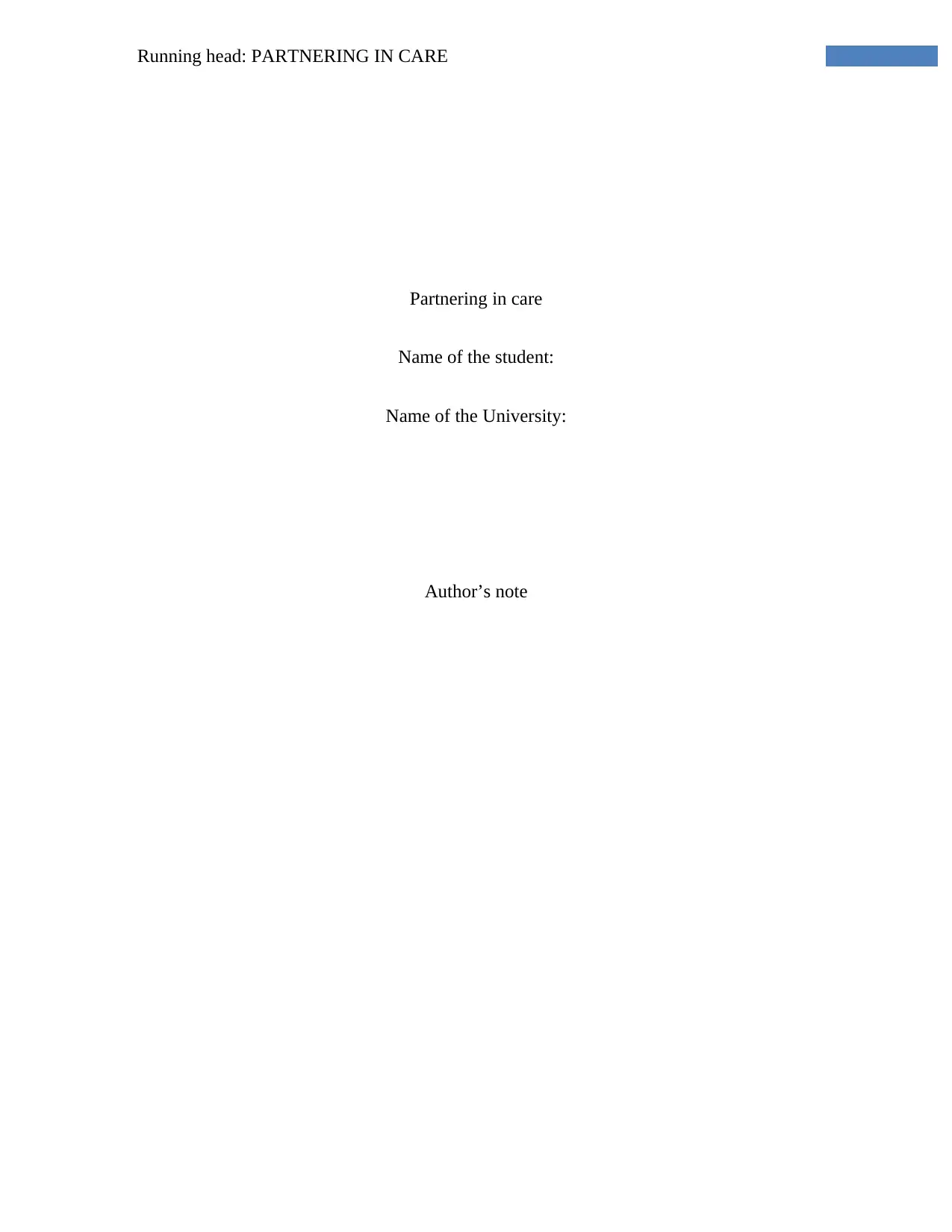
Running head: PARTNERING IN CARE
Partnering in care
Name of the student:
Name of the University:
Author’s note
Partnering in care
Name of the student:
Name of the University:
Author’s note
Secure Best Marks with AI Grader
Need help grading? Try our AI Grader for instant feedback on your assignments.
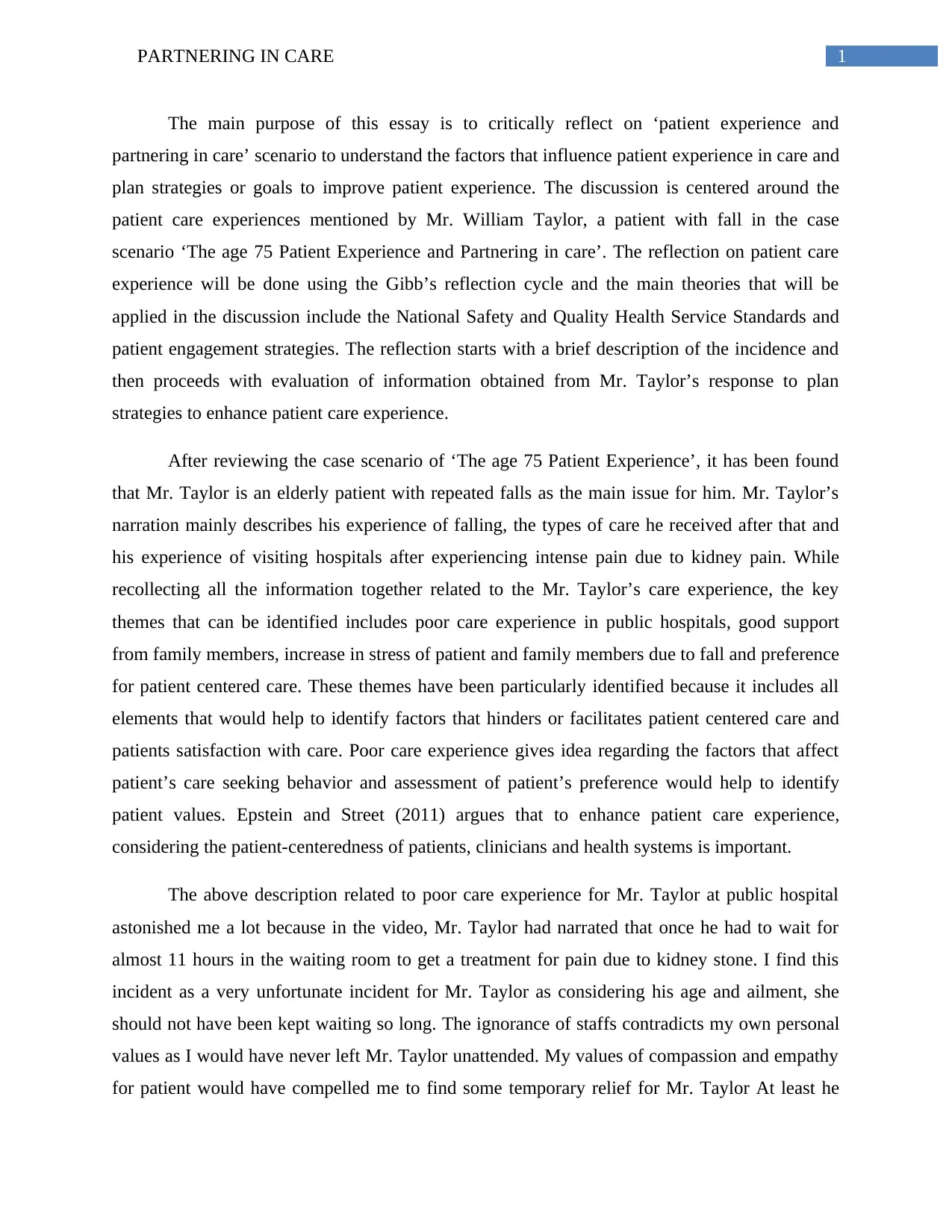
1PARTNERING IN CARE
The main purpose of this essay is to critically reflect on ‘patient experience and
partnering in care’ scenario to understand the factors that influence patient experience in care and
plan strategies or goals to improve patient experience. The discussion is centered around the
patient care experiences mentioned by Mr. William Taylor, a patient with fall in the case
scenario ‘The age 75 Patient Experience and Partnering in care’. The reflection on patient care
experience will be done using the Gibb’s reflection cycle and the main theories that will be
applied in the discussion include the National Safety and Quality Health Service Standards and
patient engagement strategies. The reflection starts with a brief description of the incidence and
then proceeds with evaluation of information obtained from Mr. Taylor’s response to plan
strategies to enhance patient care experience.
After reviewing the case scenario of ‘The age 75 Patient Experience’, it has been found
that Mr. Taylor is an elderly patient with repeated falls as the main issue for him. Mr. Taylor’s
narration mainly describes his experience of falling, the types of care he received after that and
his experience of visiting hospitals after experiencing intense pain due to kidney pain. While
recollecting all the information together related to the Mr. Taylor’s care experience, the key
themes that can be identified includes poor care experience in public hospitals, good support
from family members, increase in stress of patient and family members due to fall and preference
for patient centered care. These themes have been particularly identified because it includes all
elements that would help to identify factors that hinders or facilitates patient centered care and
patients satisfaction with care. Poor care experience gives idea regarding the factors that affect
patient’s care seeking behavior and assessment of patient’s preference would help to identify
patient values. Epstein and Street (2011) argues that to enhance patient care experience,
considering the patient-centeredness of patients, clinicians and health systems is important.
The above description related to poor care experience for Mr. Taylor at public hospital
astonished me a lot because in the video, Mr. Taylor had narrated that once he had to wait for
almost 11 hours in the waiting room to get a treatment for pain due to kidney stone. I find this
incident as a very unfortunate incident for Mr. Taylor as considering his age and ailment, she
should not have been kept waiting so long. The ignorance of staffs contradicts my own personal
values as I would have never left Mr. Taylor unattended. My values of compassion and empathy
for patient would have compelled me to find some temporary relief for Mr. Taylor At least he
The main purpose of this essay is to critically reflect on ‘patient experience and
partnering in care’ scenario to understand the factors that influence patient experience in care and
plan strategies or goals to improve patient experience. The discussion is centered around the
patient care experiences mentioned by Mr. William Taylor, a patient with fall in the case
scenario ‘The age 75 Patient Experience and Partnering in care’. The reflection on patient care
experience will be done using the Gibb’s reflection cycle and the main theories that will be
applied in the discussion include the National Safety and Quality Health Service Standards and
patient engagement strategies. The reflection starts with a brief description of the incidence and
then proceeds with evaluation of information obtained from Mr. Taylor’s response to plan
strategies to enhance patient care experience.
After reviewing the case scenario of ‘The age 75 Patient Experience’, it has been found
that Mr. Taylor is an elderly patient with repeated falls as the main issue for him. Mr. Taylor’s
narration mainly describes his experience of falling, the types of care he received after that and
his experience of visiting hospitals after experiencing intense pain due to kidney pain. While
recollecting all the information together related to the Mr. Taylor’s care experience, the key
themes that can be identified includes poor care experience in public hospitals, good support
from family members, increase in stress of patient and family members due to fall and preference
for patient centered care. These themes have been particularly identified because it includes all
elements that would help to identify factors that hinders or facilitates patient centered care and
patients satisfaction with care. Poor care experience gives idea regarding the factors that affect
patient’s care seeking behavior and assessment of patient’s preference would help to identify
patient values. Epstein and Street (2011) argues that to enhance patient care experience,
considering the patient-centeredness of patients, clinicians and health systems is important.
The above description related to poor care experience for Mr. Taylor at public hospital
astonished me a lot because in the video, Mr. Taylor had narrated that once he had to wait for
almost 11 hours in the waiting room to get a treatment for pain due to kidney stone. I find this
incident as a very unfortunate incident for Mr. Taylor as considering his age and ailment, she
should not have been kept waiting so long. The ignorance of staffs contradicts my own personal
values as I would have never left Mr. Taylor unattended. My values of compassion and empathy
for patient would have compelled me to find some temporary relief for Mr. Taylor At least he
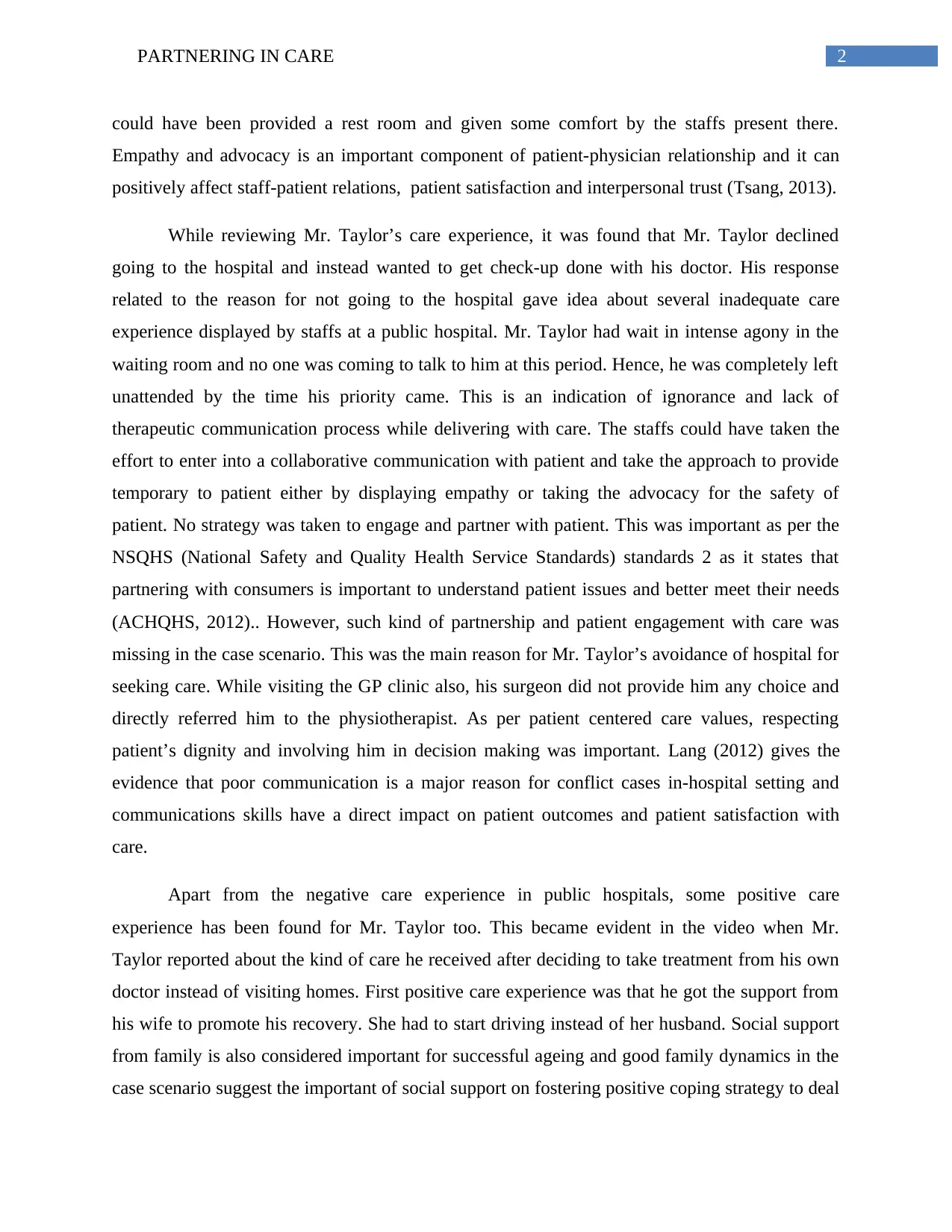
2PARTNERING IN CARE
could have been provided a rest room and given some comfort by the staffs present there.
Empathy and advocacy is an important component of patient-physician relationship and it can
positively affect staff-patient relations, patient satisfaction and interpersonal trust (Tsang, 2013).
While reviewing Mr. Taylor’s care experience, it was found that Mr. Taylor declined
going to the hospital and instead wanted to get check-up done with his doctor. His response
related to the reason for not going to the hospital gave idea about several inadequate care
experience displayed by staffs at a public hospital. Mr. Taylor had wait in intense agony in the
waiting room and no one was coming to talk to him at this period. Hence, he was completely left
unattended by the time his priority came. This is an indication of ignorance and lack of
therapeutic communication process while delivering with care. The staffs could have taken the
effort to enter into a collaborative communication with patient and take the approach to provide
temporary to patient either by displaying empathy or taking the advocacy for the safety of
patient. No strategy was taken to engage and partner with patient. This was important as per the
NSQHS (National Safety and Quality Health Service Standards) standards 2 as it states that
partnering with consumers is important to understand patient issues and better meet their needs
(ACHQHS, 2012).. However, such kind of partnership and patient engagement with care was
missing in the case scenario. This was the main reason for Mr. Taylor’s avoidance of hospital for
seeking care. While visiting the GP clinic also, his surgeon did not provide him any choice and
directly referred him to the physiotherapist. As per patient centered care values, respecting
patient’s dignity and involving him in decision making was important. Lang (2012) gives the
evidence that poor communication is a major reason for conflict cases in-hospital setting and
communications skills have a direct impact on patient outcomes and patient satisfaction with
care.
Apart from the negative care experience in public hospitals, some positive care
experience has been found for Mr. Taylor too. This became evident in the video when Mr.
Taylor reported about the kind of care he received after deciding to take treatment from his own
doctor instead of visiting homes. First positive care experience was that he got the support from
his wife to promote his recovery. She had to start driving instead of her husband. Social support
from family is also considered important for successful ageing and good family dynamics in the
case scenario suggest the important of social support on fostering positive coping strategy to deal
could have been provided a rest room and given some comfort by the staffs present there.
Empathy and advocacy is an important component of patient-physician relationship and it can
positively affect staff-patient relations, patient satisfaction and interpersonal trust (Tsang, 2013).
While reviewing Mr. Taylor’s care experience, it was found that Mr. Taylor declined
going to the hospital and instead wanted to get check-up done with his doctor. His response
related to the reason for not going to the hospital gave idea about several inadequate care
experience displayed by staffs at a public hospital. Mr. Taylor had wait in intense agony in the
waiting room and no one was coming to talk to him at this period. Hence, he was completely left
unattended by the time his priority came. This is an indication of ignorance and lack of
therapeutic communication process while delivering with care. The staffs could have taken the
effort to enter into a collaborative communication with patient and take the approach to provide
temporary to patient either by displaying empathy or taking the advocacy for the safety of
patient. No strategy was taken to engage and partner with patient. This was important as per the
NSQHS (National Safety and Quality Health Service Standards) standards 2 as it states that
partnering with consumers is important to understand patient issues and better meet their needs
(ACHQHS, 2012).. However, such kind of partnership and patient engagement with care was
missing in the case scenario. This was the main reason for Mr. Taylor’s avoidance of hospital for
seeking care. While visiting the GP clinic also, his surgeon did not provide him any choice and
directly referred him to the physiotherapist. As per patient centered care values, respecting
patient’s dignity and involving him in decision making was important. Lang (2012) gives the
evidence that poor communication is a major reason for conflict cases in-hospital setting and
communications skills have a direct impact on patient outcomes and patient satisfaction with
care.
Apart from the negative care experience in public hospitals, some positive care
experience has been found for Mr. Taylor too. This became evident in the video when Mr.
Taylor reported about the kind of care he received after deciding to take treatment from his own
doctor instead of visiting homes. First positive care experience was that he got the support from
his wife to promote his recovery. She had to start driving instead of her husband. Social support
from family is also considered important for successful ageing and good family dynamics in the
case scenario suggest the important of social support on fostering positive coping strategy to deal
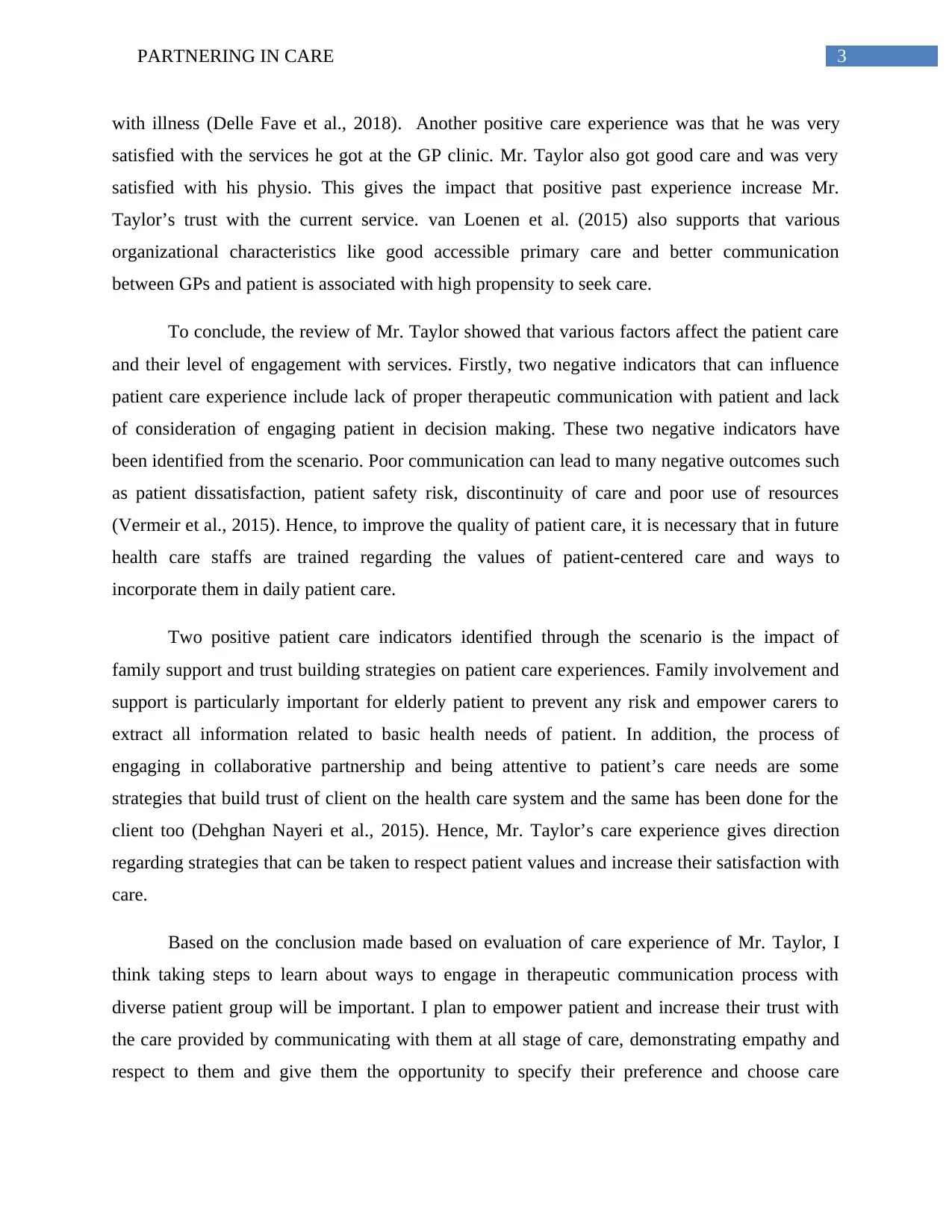
3PARTNERING IN CARE
with illness (Delle Fave et al., 2018). Another positive care experience was that he was very
satisfied with the services he got at the GP clinic. Mr. Taylor also got good care and was very
satisfied with his physio. This gives the impact that positive past experience increase Mr.
Taylor’s trust with the current service. van Loenen et al. (2015) also supports that various
organizational characteristics like good accessible primary care and better communication
between GPs and patient is associated with high propensity to seek care.
To conclude, the review of Mr. Taylor showed that various factors affect the patient care
and their level of engagement with services. Firstly, two negative indicators that can influence
patient care experience include lack of proper therapeutic communication with patient and lack
of consideration of engaging patient in decision making. These two negative indicators have
been identified from the scenario. Poor communication can lead to many negative outcomes such
as patient dissatisfaction, patient safety risk, discontinuity of care and poor use of resources
(Vermeir et al., 2015). Hence, to improve the quality of patient care, it is necessary that in future
health care staffs are trained regarding the values of patient-centered care and ways to
incorporate them in daily patient care.
Two positive patient care indicators identified through the scenario is the impact of
family support and trust building strategies on patient care experiences. Family involvement and
support is particularly important for elderly patient to prevent any risk and empower carers to
extract all information related to basic health needs of patient. In addition, the process of
engaging in collaborative partnership and being attentive to patient’s care needs are some
strategies that build trust of client on the health care system and the same has been done for the
client too (Dehghan Nayeri et al., 2015). Hence, Mr. Taylor’s care experience gives direction
regarding strategies that can be taken to respect patient values and increase their satisfaction with
care.
Based on the conclusion made based on evaluation of care experience of Mr. Taylor, I
think taking steps to learn about ways to engage in therapeutic communication process with
diverse patient group will be important. I plan to empower patient and increase their trust with
the care provided by communicating with them at all stage of care, demonstrating empathy and
respect to them and give them the opportunity to specify their preference and choose care
with illness (Delle Fave et al., 2018). Another positive care experience was that he was very
satisfied with the services he got at the GP clinic. Mr. Taylor also got good care and was very
satisfied with his physio. This gives the impact that positive past experience increase Mr.
Taylor’s trust with the current service. van Loenen et al. (2015) also supports that various
organizational characteristics like good accessible primary care and better communication
between GPs and patient is associated with high propensity to seek care.
To conclude, the review of Mr. Taylor showed that various factors affect the patient care
and their level of engagement with services. Firstly, two negative indicators that can influence
patient care experience include lack of proper therapeutic communication with patient and lack
of consideration of engaging patient in decision making. These two negative indicators have
been identified from the scenario. Poor communication can lead to many negative outcomes such
as patient dissatisfaction, patient safety risk, discontinuity of care and poor use of resources
(Vermeir et al., 2015). Hence, to improve the quality of patient care, it is necessary that in future
health care staffs are trained regarding the values of patient-centered care and ways to
incorporate them in daily patient care.
Two positive patient care indicators identified through the scenario is the impact of
family support and trust building strategies on patient care experiences. Family involvement and
support is particularly important for elderly patient to prevent any risk and empower carers to
extract all information related to basic health needs of patient. In addition, the process of
engaging in collaborative partnership and being attentive to patient’s care needs are some
strategies that build trust of client on the health care system and the same has been done for the
client too (Dehghan Nayeri et al., 2015). Hence, Mr. Taylor’s care experience gives direction
regarding strategies that can be taken to respect patient values and increase their satisfaction with
care.
Based on the conclusion made based on evaluation of care experience of Mr. Taylor, I
think taking steps to learn about ways to engage in therapeutic communication process with
diverse patient group will be important. I plan to empower patient and increase their trust with
the care provided by communicating with them at all stage of care, demonstrating empathy and
respect to them and give them the opportunity to specify their preference and choose care
Secure Best Marks with AI Grader
Need help grading? Try our AI Grader for instant feedback on your assignments.
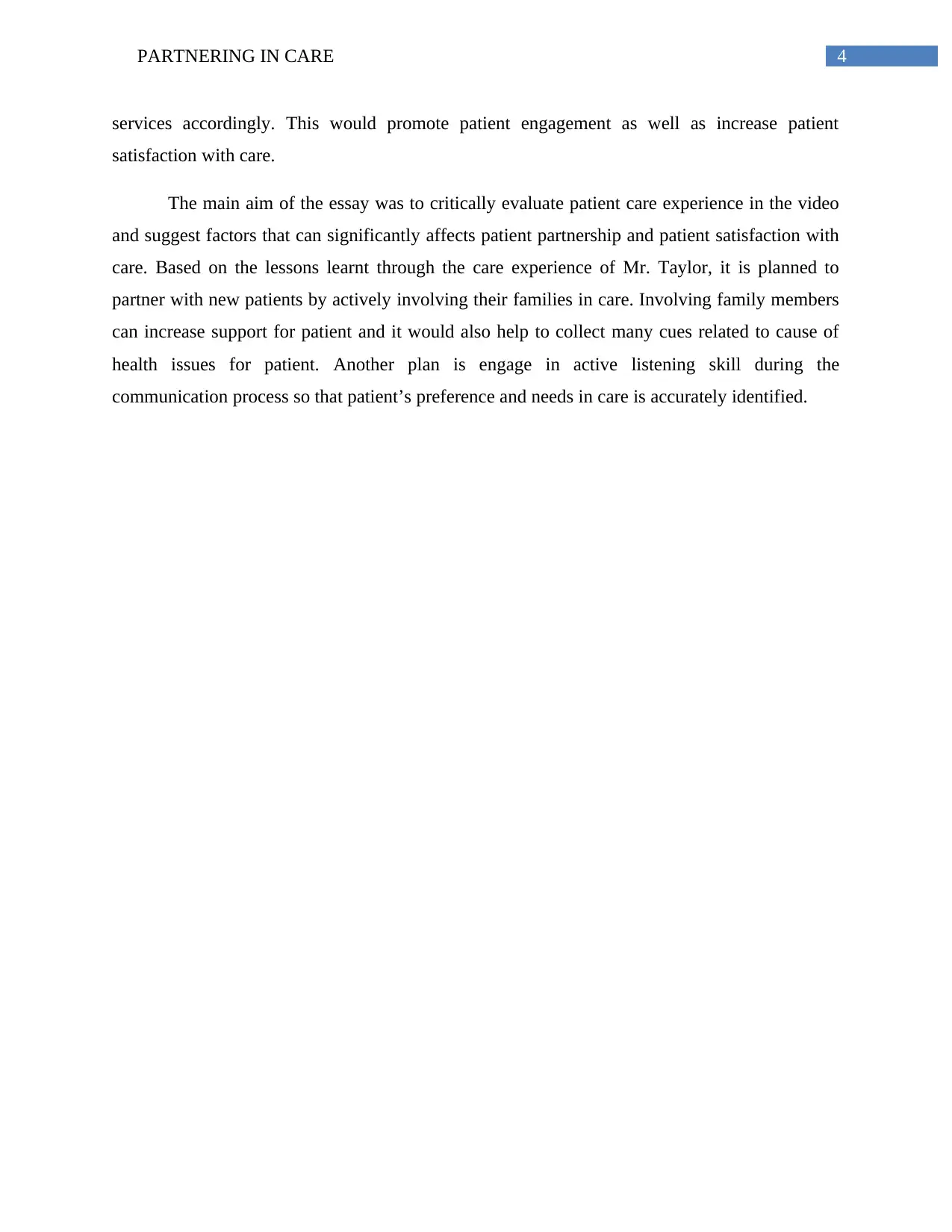
4PARTNERING IN CARE
services accordingly. This would promote patient engagement as well as increase patient
satisfaction with care.
The main aim of the essay was to critically evaluate patient care experience in the video
and suggest factors that can significantly affects patient partnership and patient satisfaction with
care. Based on the lessons learnt through the care experience of Mr. Taylor, it is planned to
partner with new patients by actively involving their families in care. Involving family members
can increase support for patient and it would also help to collect many cues related to cause of
health issues for patient. Another plan is engage in active listening skill during the
communication process so that patient’s preference and needs in care is accurately identified.
services accordingly. This would promote patient engagement as well as increase patient
satisfaction with care.
The main aim of the essay was to critically evaluate patient care experience in the video
and suggest factors that can significantly affects patient partnership and patient satisfaction with
care. Based on the lessons learnt through the care experience of Mr. Taylor, it is planned to
partner with new patients by actively involving their families in care. Involving family members
can increase support for patient and it would also help to collect many cues related to cause of
health issues for patient. Another plan is engage in active listening skill during the
communication process so that patient’s preference and needs in care is accurately identified.
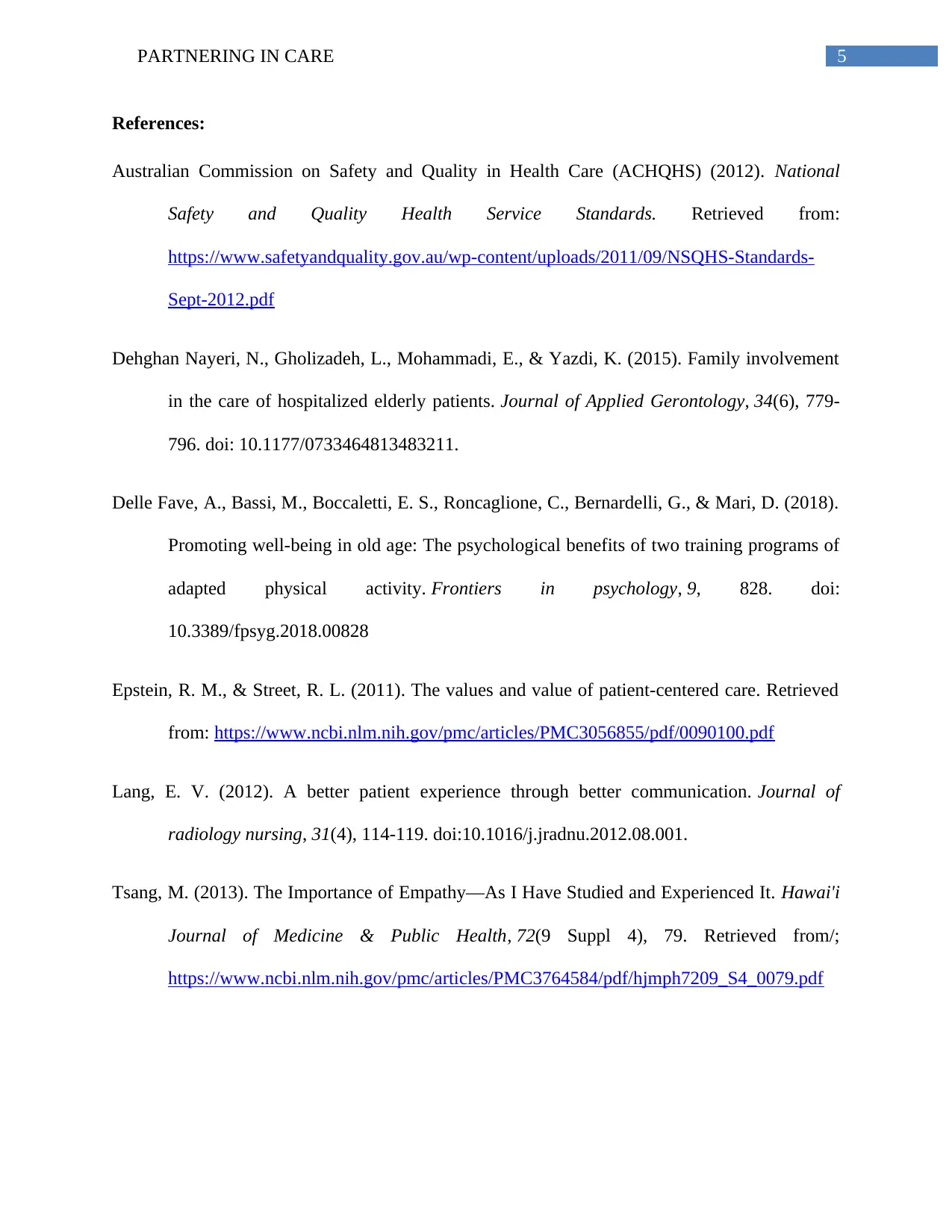
5PARTNERING IN CARE
References:
Australian Commission on Safety and Quality in Health Care (ACHQHS) (2012). National
Safety and Quality Health Service Standards. Retrieved from:
https://www.safetyandquality.gov.au/wp-content/uploads/2011/09/NSQHS-Standards-
Sept-2012.pdf
Dehghan Nayeri, N., Gholizadeh, L., Mohammadi, E., & Yazdi, K. (2015). Family involvement
in the care of hospitalized elderly patients. Journal of Applied Gerontology, 34(6), 779-
796. doi: 10.1177/0733464813483211.
Delle Fave, A., Bassi, M., Boccaletti, E. S., Roncaglione, C., Bernardelli, G., & Mari, D. (2018).
Promoting well-being in old age: The psychological benefits of two training programs of
adapted physical activity. Frontiers in psychology, 9, 828. doi:
10.3389/fpsyg.2018.00828
Epstein, R. M., & Street, R. L. (2011). The values and value of patient-centered care. Retrieved
from: https://www.ncbi.nlm.nih.gov/pmc/articles/PMC3056855/pdf/0090100.pdf
Lang, E. V. (2012). A better patient experience through better communication. Journal of
radiology nursing, 31(4), 114-119. doi:10.1016/j.jradnu.2012.08.001.
Tsang, M. (2013). The Importance of Empathy—As I Have Studied and Experienced It. Hawai'i
Journal of Medicine & Public Health, 72(9 Suppl 4), 79. Retrieved from/;
https://www.ncbi.nlm.nih.gov/pmc/articles/PMC3764584/pdf/hjmph7209_S4_0079.pdf
References:
Australian Commission on Safety and Quality in Health Care (ACHQHS) (2012). National
Safety and Quality Health Service Standards. Retrieved from:
https://www.safetyandquality.gov.au/wp-content/uploads/2011/09/NSQHS-Standards-
Sept-2012.pdf
Dehghan Nayeri, N., Gholizadeh, L., Mohammadi, E., & Yazdi, K. (2015). Family involvement
in the care of hospitalized elderly patients. Journal of Applied Gerontology, 34(6), 779-
796. doi: 10.1177/0733464813483211.
Delle Fave, A., Bassi, M., Boccaletti, E. S., Roncaglione, C., Bernardelli, G., & Mari, D. (2018).
Promoting well-being in old age: The psychological benefits of two training programs of
adapted physical activity. Frontiers in psychology, 9, 828. doi:
10.3389/fpsyg.2018.00828
Epstein, R. M., & Street, R. L. (2011). The values and value of patient-centered care. Retrieved
from: https://www.ncbi.nlm.nih.gov/pmc/articles/PMC3056855/pdf/0090100.pdf
Lang, E. V. (2012). A better patient experience through better communication. Journal of
radiology nursing, 31(4), 114-119. doi:10.1016/j.jradnu.2012.08.001.
Tsang, M. (2013). The Importance of Empathy—As I Have Studied and Experienced It. Hawai'i
Journal of Medicine & Public Health, 72(9 Suppl 4), 79. Retrieved from/;
https://www.ncbi.nlm.nih.gov/pmc/articles/PMC3764584/pdf/hjmph7209_S4_0079.pdf
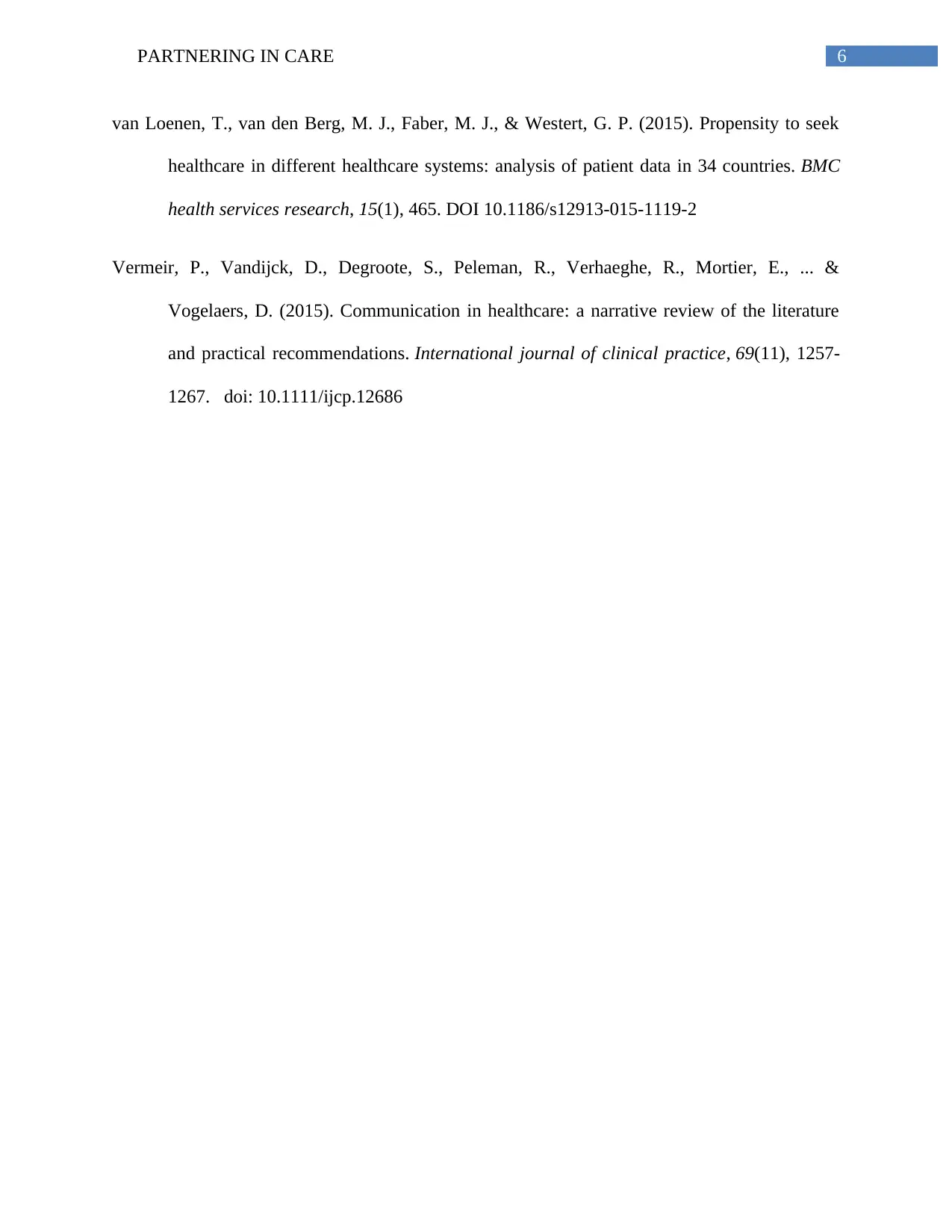
6PARTNERING IN CARE
van Loenen, T., van den Berg, M. J., Faber, M. J., & Westert, G. P. (2015). Propensity to seek
healthcare in different healthcare systems: analysis of patient data in 34 countries. BMC
health services research, 15(1), 465. DOI 10.1186/s12913-015-1119-2
Vermeir, P., Vandijck, D., Degroote, S., Peleman, R., Verhaeghe, R., Mortier, E., ... &
Vogelaers, D. (2015). Communication in healthcare: a narrative review of the literature
and practical recommendations. International journal of clinical practice, 69(11), 1257-
1267. doi: 10.1111/ijcp.12686
van Loenen, T., van den Berg, M. J., Faber, M. J., & Westert, G. P. (2015). Propensity to seek
healthcare in different healthcare systems: analysis of patient data in 34 countries. BMC
health services research, 15(1), 465. DOI 10.1186/s12913-015-1119-2
Vermeir, P., Vandijck, D., Degroote, S., Peleman, R., Verhaeghe, R., Mortier, E., ... &
Vogelaers, D. (2015). Communication in healthcare: a narrative review of the literature
and practical recommendations. International journal of clinical practice, 69(11), 1257-
1267. doi: 10.1111/ijcp.12686
1 out of 7
Related Documents
Your All-in-One AI-Powered Toolkit for Academic Success.
+13062052269
info@desklib.com
Available 24*7 on WhatsApp / Email
![[object Object]](/_next/static/media/star-bottom.7253800d.svg)
Unlock your academic potential
© 2024 | Zucol Services PVT LTD | All rights reserved.




